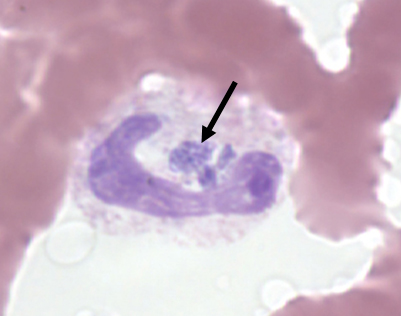Tests
1st tests to order
CBC
Test
Leukopenia with absolute and relative lymphopenia is common during first week of the disease; usually associated with thrombocytopenia.
Marked absolute and relative rebound lymphocytoses are seen during second week of illness.[68]
Leukopenia or thrombocytopenia is present in up to two-thirds of patients at time of presentation.
Normal counts do not rule out diagnosis.
Anemia is less frequent.
Result
leukopenia; thrombocytopenia
LFTs
Test
Usually shows mildly to moderately elevated aminotransferases.
Bilirubin and alkaline phosphatase are usually within normal limits unless patient is already in critical condition (e.g., septic shock).
Result
elevated
peripheral blood smear
Test
Careful evaluation of peripheral blood smear is recommended to detect cytoplasmic morulae (Ehrlichia/Anaplasma inclusions) in leukocytes. [Figure caption and citation for the preceding image starts]: Peripheral blood smear showing intracytoplasmic morulae (arrow) of Anaplasma phagocytophilum in a polymorphonuclear neutrophil (Giemsa stain, 1000x)Courtesy of J. Stephen Dumler, MD [Citation ends].
Although this is a recommended investigation, detection of morulae is considered insensitive as a diagnostic test in immunocompetent patients. However, in clinical experience, in immunocompromised patients a peripheral blood smear examination performed by an experienced hematologist may confirm the diagnosis more quickly.[67]
Present in <10% of human monocytotropic/monocytic ehrlichiosis (HME) cases and 25% to 75% of human granulocytotropic/granulocytic anaplasmosis (HGA) cases.[17][48][62][63][66][69][70][99]
Result
cytoplasmic morulae in infected leukocytes
Tests to consider
immunofluorescence antibody assay
Test
Diagnostic for human monocytotropic/monocytic ehrlichiosis (HME) and human granulocytotropic/granulocytic anaplasmosis (HGA).[71][76][77][101]
Paired samples should be obtained during the acute and convalescent phases (i.e., 2-4 weeks later) to demonstrate rising antibody titers. A fourfold or greater increase in antibody titer is diagnostic.[68]
Sensitivity in paired samples approaches 100% with some false-negatives documented in patients who receive very early antibiotic treatment based on high clinical suspicion or in patients with AIDS.
Specificity varies greatly depending on timing of testing and serologic cross-reactions between Ehrlichia and Anaplasma species.
Cannot be used for diagnosis of human ewingii ehrlichiosis (HEE) due to extensive cross-reactive antibodies with E chaffeensis.
Result
antibodies against Ehrlichia chaffeensis or Anaplasma phagocytophilum
polymerase chain reaction
Test
Detects ehrlichial nucleic acids (DNA/RNA) from peripheral blood/tissue specimen using primers targeting a particular ehrlichial gene.[4][48][73][76][77]
Available at specialized centers only (e.g., CDC, large reference laboratories and academic research laboratories).
Initial blood sample should be collected in a red-top tube for baseline serologic assays and ethylenediamine tetraacetic acid (EDTA)- or citrate-containing tubes.
Sensitivity and specificity depend on reaction conditions and protocol (e.g., DNA primers), and whether treatment has been administered prior to collection of sample to be processed by polymerase chain reaction (PCR).
PCR using primers specific for E ewingii is the only diagnostic method available for human ewingii ehrlichiosis (HEE);E ewingii is not culturable.[4][88]
Result
Ehrlichia or Anaplasma DNA/RNA
Emerging tests
Western immunoblotting
Test
Useful to confirm immunofluorescence antibody assay (IFA) or differentiate between E chaffeensis and A phagocytophilum infections in areas where the 2 bacteria are endemic (e.g., mid-Atlantic and Northeastern states).[63][102][103][104][105][106][107][108][109]
Analytical sensitivity is theoretically higher than with IFA, although it has not been evaluated systematically.
Available only in highly specialized research laboratories.
Result
antibodies against Ehrlichia chaffeensis or Anaplasma phagocytophilum in serum
culture
Test
Requires cell monolayers for isolation and is cumbersome, time consuming, and costly. Growth takes several days to weeks.
Highly dependent on rapid inoculation after obtaining sample from patient.
Isolated more frequently in patients with HIV/AIDS.
Sample should be obtained at initial presentation before starting antibiotic treatment.
Available only in highly specialized research laboratories.
Result
Ehrlichia chaffeensis or Anaplasma phagocytophilum isolated from blood sample
Use of this content is subject to our disclaimer